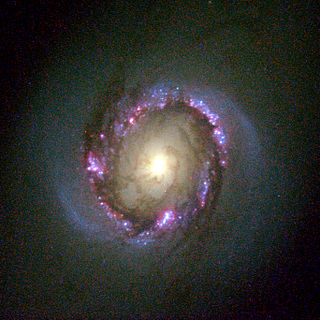
NGC 4314 is a barred spiral galaxy approximately 53 million light-years away in the northern constellation of Coma Berenices. It is positioned around 3° to the north and slightly west of the star Gamma Comae Berenices and is visible in a small telescope. The galaxy was discovered by German-born astronomer William Herschel on March 13, 1785. It was labelled as peculiar by Allan Sandage in 1961 because of the unusual structure in the center of the bar. NGC 4314 is a member of the Coma I group of galaxies.

NGC 3384 is an elliptical galaxy in the constellation Leo. The galaxy was discovered by William Herschel in 1784 as part of the Herschel 400 Catalogue. The high age of the stars in the central region of NGC 3384 was confirmed after analysis of their color. More than 80% were found to be Population II stars which are over a billion years old. The supermassive black hole at the core has a mass of 1.6+0.1
−0.2×107 M☉.

NGC 3607 is a small but fairly bright lenticular galaxy in the equatorial constellation of Leo, about 2.5° south of the prominent star Delta Leonis. The galaxy was discovered March 14, 1784 by William Herschel. Dreyer described it as "very bright, large, round, very much brighter middle, 2nd of 3". It is located at a distance of 73 million light years and is receding with a radial velocity of 930 km/s. The galaxy lies southwest of NGC 3626 at an angular separation of ~50′. It occupies the center of the Leo II Group of galaxies, forming one of its two brightest members – the other being NGC 3608. It is a member of the NGC 3607 Group of galaxies, which is a member of the Leo II Groups, a series of galaxies and galaxy clusters strung out from the right edge of the Virgo Supercluster.

NGC 2281, also known as the Broken Heart Cluster, is an open cluster of stars in the northern constellation of Auriga. It was discovered by English astronomer William Herschel on March 4, 1788, and described as a, "cluster of coarsely scattered pretty [bright] stars, pretty rich". The Trumpler class for NGC 2281 is I3p, indicating a poor (p) but compact (I) grouping with a wide range of brightness (3). It is located at a distance of approximately 1,720 ly from the Sun and is 630–661 million years old.

NGC 1664 is an open cluster in the constellation of Auriga. It contains stars with a total of around 640 solar masses with a tidal radius of 43 ly (13.2 pc).

NGC 4030 is a grand design spiral galaxy located about 64 million light years away in the constellation Virgo. It is a member of the NGC 4030 Group of galaxies, which is a member of the Virgo II Groups, a series of galaxies and galaxy clusters strung out from the southern edge of the Virgo Supercluster. With an apparent visual magnitude of 10.6, it is visible with a small telescope as a 3 arc minute wide feature about 4.75° to the southeast of the star Beta Virginis. It is inclined by an angle of 47.1° to the line of sight from the Earth and is receding at a velocity of 1,465 km/s.

NGC 4102 is an intermediate barred spiral galaxy located in the northern constellation of Ursa Major. It is visible in a small telescope and has an apparent visual magnitude of 11.2. The galaxy was discovered April 12, 1789 by William Herschel. J. L. E. Dreyer described it as "bright, pretty small, round, brighter middle and bright nucleus". This galaxy is located at a distance of 60 million light years and is receding with a heliocentric radial velocity of 837 km/s. It is a member of the Ursa Major group of galaxies.

NGC 2613 is a spiral galaxy in the southern constellation of Pyxis, next to the western constellation border with Puppis. It was discovered by the German-born astronomer William Herschel on November 20, 1784. With an apparent visual magnitude of 10.5, the galaxy is faintly visible using a telescope with a 100 mm (4 in) aperture. It appears spindle-shaped as it is almost edge-on to observers on Earth.

NGC 4203 is the New General Catalogue identifier for a lenticular galaxy in the northern constellation of Coma Berenices. It was discovered on March 20, 1787 by English astronomer William Herschel, and is situated 5.5° to the northwest of the 4th magnitude star Gamma Comae Berenices and can be viewed with a small telescope. The morphological classification of NGC 4203 is SAB0−, indicating that it has a lenticular form with tightly wound spiral arms and a weak bar structure at the nucleus.

NGC 6939 is an open cluster in the constellation Cepheus. It was discovered by William Herschel in 1798. The cluster lies 2/3° northwest from the spiral galaxy NGC 6946. The cluster lies approximately 4,000 light years away and it is over a billion years old.
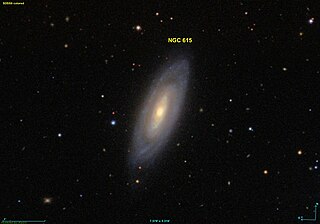
NGC 615 is an unbarred spiral galaxy seen edge-on located in the constellation Cetus. It is located at a distance of circa 70 million light years from Earth, which, given its apparent dimensions, means that NGC 615 is about 75,000 light years across. It was discovered by William Herschel on January 10, 1785. NGC 615 belongs to the NGC 584 galaxy group, which also includes the galaxies NGC 584, NGC 596, NGC 600, and NGC 636.
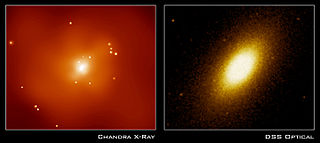
NGC 720 is an elliptical galaxy located in the constellation Cetus. It is located at a distance of circa 80 million light years from Earth, which, given its apparent dimensions, means that NGC 720 is about 110,000 light years across. It was discovered by William Herschel on October 3, 1785. The galaxy is included in the Herschel 400 Catalogue. It lies about three and a half degrees south and slightly east from zeta Ceti.

NGC 7606 is a spiral galaxy located in the constellation Aquarius. It is located at a distance of circa 100 million light years from Earth, which, given its apparent dimensions, means that NGC 7606 is about 165,000 light years across. It was discovered by William Herschel on September 28, 1785. The galaxy is included in the Herschel 400 Catalogue. It lies 45 arcminutes northeast from psi2 Aquarii. It can be seen with a 4 inch telescope but its visibility is greatly affected by light pollution.

NGC 7723 is a barred spiral galaxy located in the constellation Aquarius. It is located at a distance of circa 90 million light years from Earth, which, given its apparent dimensions, means that NGC 7723 is about 95,000 light years across. It was discovered by William Herschel on November 27, 1785. The galaxy is included in the Herschel 400 Catalogue. It lies 1.5 degrees north-northwest from Omega1 Aquarii. It can be seen with a 4-inch telescope under dark skies.
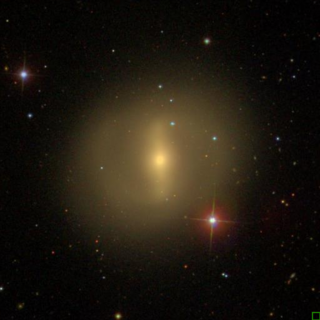
NGC 4665, also catalogued as NGC 4624 and NGC 4664, is a barred lenticular or spiral galaxy located in the constellation Virgo. It is a member of the Virgo II Groups, a series of galaxies and galaxy clusters strung out from the southern edge of the Virgo Supercluster. It is located at a distance of circa 60 million light years from Earth, which, given its apparent dimensions, means that NGC 4665 is about 75,000 light years across. NGC 4665 lies 2 and 3/4 degrees east-south east of Delta Virginis and 50 arcminutes southwest of 35 Virginis. It can be viewed through a moderately sized telescope with 23x magnification, forming a pair with an 11th magnitude star 1.5 arcminutes southwest. It is part of the Herschel 400 Catalogue.

NGC 5846 is an elliptical galaxy located in the constellation Virgo. It is located at a distance of circa 90 million light years from Earth, which, given its apparent dimensions, means that NGC 5846 is about 110,000 light years across. It was discovered by William Herschel on February 24, 1786. It lies near 110 Virginis and is part of the Herschel 400 Catalogue. It is a member of the NGC 5846 Group of galaxies, itself one of the Virgo III Groups strung out to the east of the Virgo Supercluster of galaxies.

NGC 779 is a spiral galaxy seen edge-on, located in the constellation Cetus. It is located at a distance of circa 60 million light years from Earth, which, given its apparent dimensions, means that NGC 779 is about 70,000 light years across. It was discovered by William Herschel on September 10, 1785.

NGC 3640 is an elliptical galaxy located in the constellation Leo. It is located at a distance of circa 75 million light years from Earth, which, given its apparent dimensions, means that NGC 3640 is about 90,000 light years across. It was discovered by William Herschel on February 23, 1784. It is a member of the NGC 3640 Group of galaxies, which is a member of the Leo II Groups, a series of galaxies and galaxy clusters strung out from the right edge of the Virgo Supercluster.

NGC 4278 is an elliptical galaxy located in the constellation Coma Berenices. It is located at a distance of circa 55 million light years from Earth, which, given its apparent dimensions, means that NGC 4278 is about 65,000 light years across. It was discovered by William Herschel on March 13, 1785. NGC 4278 is part of the Herschel 400 Catalogue and can be found about one and 3/4 of a degree northwest of Gamma Comae Berenices even with a small telescope.
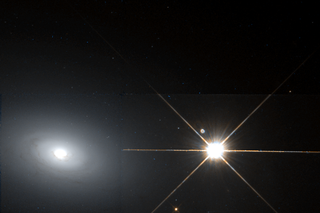
NGC 2974 is a lenticular galaxy located in the constellation Sextans. It is located at a distance of circa 90 million light years from Earth, which, given its apparent dimensions, means that NGC 2974 is about 90,000 light years across. It was discovered by William Herschel on January 6, 1785. NGC 2974 is located in the sky about 2 and a half degrees south-south east of Iota Hydrae and more than 6 degrees northeast of Alphard. A 10th magnitude star lies next to the galaxy, thus making it a challenging object at low magnifications. NGC 2974 is part of the Herschel 400 Catalogue.





















